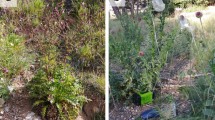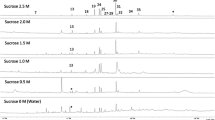Abstract
A new bioassay employing a natural fungivore, the opossumDidelphis virginiana, is described. Using this bioasssay, eighteen species of fungi were tested for palatability. Five species of mushrooms, all of which taste pungent to humans, were found to be unpalatable to the opossum. From the least palatable of these,Lentinellus ursinus, the pungent principle was isolated and identified as isovelleral, a previously described fungal metabolite. The compound was shown to be a potent antifeedant to opossums. By means of difference NOE and relaxation time NMR studies, the relative configuration and solution conformation of isovelleral were deduced.
Similar content being viewed by others
References
Andina, D., DeBernardi, M., Del Vecchio, A., Fronza, G., Mellerio, G., Vidari, G., andVita-Finzi, P. 1980. Sesquiterpenes fromRussula sardonia.Phytochemistry 19:93–97.
Camazine, S. 1983. Mushroom chemical defense: Food-aversion learning induced by hallucinogenic toxin, muscimol.J. Chem. Ecol. 9:1473–1481.
Eisner, T., Wiemer, D.F., Haynes, L.W., andMeinwald, J. 1978. Lucibufagins: Defensive steroids from the firefliesPhotinus ignitus andP. marginellus (Coleoptera: Lampyridae).Proc. Natl. Acad. Sci. U.S.A. 75:905–908.
Hall, L.D., andSanders, J.K.M. 1980. Complete analysis of1H NMR spectra of complex natural products using a combination of one- and two-dimensional techniques. 1-Dehydrotestosterone.J. Am. Chem. Soc. 102:5703–5711.
Hatt, R.T. 1929. The red squirrel: Its life history and habits, with special reference to the Adirondacks of New York and the Harvard Forest.Roosevelt Wild Life Ann. 2:11–146.
Hoffmann, R. 1965. Some theoretical observations on cyclopropane.Tetrahedron Lett. 1965:3819–3824.
Kubo, I. andGanjian, I. 1981. Insect antifeedant terpenes, hot-tasting to humans.Experientia 37:1063–1064.
Kubo, I., andNakanishi, K. 1979. Some terpenoid insect antifeedants from tropical plants, pp. 284–294,in H. Geissbühler (ed.). Advances in Pesticide Science, Part 2. Pergamon Press, Oxford.
Lincoff, G., andMitchel, D.R. 1977. Toxic and Hallucinogenic Mushroom Poisoning. Van Nostrand Reinhold, New York.
List, P.H., andHackenberg, H. 1969. Velleral and iso-Velleral, scharf schmeckende Stoffe ausLactarius vellereus FRIES.Arch. Pharm. Ber. Dtsch. Pharm. Ges. 302:125–143.
Magnusson, G., Thorén, S., andWickberg, G. 1972. Fungal extractives I. Structure of a sesquiterpene dialdehyde fromLactarious by computer simulation of the NMR spectrum.Tetrahedron Lett. 1972:1105–1108.
Magnusson, G., Thorén, S., andDrakenberg, T. 1973. Fungal extractives IV. Structure of a novel sesquiterpene dialdehyde fromLactarius by spectroscopic methods.Tetrahedron 29:1621–1624.
Martin, M.L., Martin, G.J. andDelpuech, J.-J. 1980. Practical NMR Spectroscopy. Heyden and Son, Philadelphia, pp. 14–24.
Nakanishi, K. 1980. Insect antifeedants from plants, pp. 603–611,in M. Locke and D.S. Smith (eds.). Insect Biology in the Future. Academic Press, New York.
Noggle, J.H., andSchirmer, R.E. 1971. The Nuclear Overhauser Effect: Chemical Applications. Academic Press, New York. pp. 4–20.
Turner, W.B. 1971. Fungal Metabolites. Academic Press, New York.
Author information
Authors and Affiliations
Rights and permissions
About this article
Cite this article
Camazine, S.M., Resch, J.F., Eisner, T. et al. Mushroom chemical defense. J Chem Ecol 9, 1439–1447 (1983). https://doi.org/10.1007/BF00990749
Received:
Revised:
Issue Date:
DOI: https://doi.org/10.1007/BF00990749




